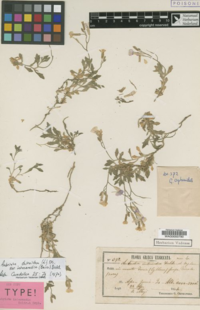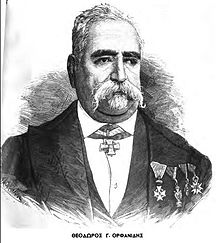|
Theodoros G. Orphanides
Theodoros Orphanides or Orphanidis (Greek: Θεόδωρος Ορφανίδης; 1817 – 5 August 1886) was a poet, professor, politician, author, and botanist. He was a pioneer in 19th-century Greek botany. He helped organize the botanical garden in Greece. The genus Orphanidesia is named after him. He collected 3483 specimens from 21 countries and identified 413 specimens from 9 different countries. He was a Professor of Botany at the National and Kapodistrian University of Athens. He was one of the leading representatives of the First Athenian School. He received the Ralio award three times.[1][2][3][4] Early lifeHe was born in Izmir but his parents were from Chios, Greece. He was from a prominent wealthy family. His older brother was Dimitris Orphanides. He was a world-renowned doctor. His nephew was Greek Olympian Georgios Orphanidis. After the outburst of the Greek Revolution, his family was forced to move to Nafplio and later Tinos. They finally settled on the island of Syros. He finished high school on the island of Syros. In 1835, at the age of 18, he moved to Athens. He was appointed ministerial scribe for the Ministry of Interior. While he lived in Athens he began to show an interest in writing political satire. Regrettably, because he was constantly criticizing the King of Greece in his political satire he was fired from the ministry and was sentenced to 3 days in jail. He published two poems with the title Menippus from 1836-1837. Four years later he was writing for the satirical newspaper (Archer) Τοξότης. In 1842, he wrote a poem entitled The First Martyr Rigas and the Greek Revolution (Ο Πρωτομάρτυς Ρήγας και η Ελληνική Επανάστασις). In 1844, at the age of 27 after the personal intervention of the Greek Prime Minister Ioannis Kolettis. Theodore was sent to France on a scholarship from the Greek government. He studied at the prestigious botanical garden of the National Museum of Natural History it was converted into a special academic research facility after the French Revolution. The institution was part of the University of Paris and Sorbonne University system. The facility had one of largest botanical gardens in the world at the time. It housed the Royal Garden of Medicinal Plants created by King Louis XIII in 1635. Theodoro's professors at the institution were Adrien-Henri de Jussieu, Adolphe-Théodore Brongniart, Joseph Decaisne and Achille Richard.[5][6][7][8] Academic career When he returned to Athens on August 11, 1850, he was appointed Professor of Botany at the National and Kapodistrian University of Athens. Four years later in 1854, he was awarded full Professor status. He maintained his position for over thirty years. The university was very political in nature. College professors usually participated in political debates and issues. Dimitrios Stroumpos and Ioannis Papadakis were some of the other professors dragged into Greece's political issues. The university faculty and government created an alliance that led to the departure of world-renowned astronomer Georgios Konstantinos Vouris. Vouris was Greek-Austrian. He was from the same country as the King of Greece. During the years 1867 – 1868 Orphanides was Rector of the University. He was tirelessly collecting floral species from all over Greece. Theodore pressed the plants using a plant press and prepared them for classification. Specimens were prepared and glued to archival-quality card stock with their labels. Labels were made with special ink and attached with archival-quality glue. Theodore prepared countless plant specimens. The dried plants were added to his herbarium some were sent to different botanists all over the world. His plant material formed a remarkable Herbarium with over 45,000 specimens. He traveled across Greece studying plant diversity. He published his findings in an exsiccata work entitled Flora Graeca Exsiccata.[9][10] Theodore was also the superintendent of the botanical garden and the state arboretum, he introduced ornamental plants and he was actively involved in the design and creation of urban public parks. He oversaw the creation of the National Garden of Athens. Theodore frequently collaborated with world-renowned botanists some included Theodor von Heldreich and Pierre Edmond Boissier. When he died his Herbarium was purchased by national benefactor Theodoros Rodokanakis. Rodokanakis donated the collection to the Botanical Museum of the University.[11] After his death in 1886, Theodor von Heldreich distributed an exsiccata-like specimen series under the title "Reliquiae Orphanideae curante Th. de Heldreich anno 188. emissae".[12] Rectors SpeechWhen Theodore became rector of the University of Athens he gave a notable speech on November 26, 1867. He discussed Greek vegetation and the classification and nomenclature of Greek flora. The speech was over 75 pages. Thirty pages of the speech were taxonomic tables where the classes, orders, and species of the Greek flora were described. Forty-five pages included the scientific clarification of botany. He was concerned with enriching the school's museum with botanical species. He was also concerned that students showed little interest in the natural sciences. He also discussed the need for a Greek botanical journal to communicate with Europe. He eventually started his own journal several years after his speech in 1872 entitled Γεωπονικά Geoponika. He noted that most of his work from touring the Greek countryside was used by world-renowned Swiss botanist Pierre Edmond Boissier in his publication. The publication gave prestige and recognition to Theodore's work. Theodore explained that Theophrastus was the father of botany but he also made reference to the modern advancements of Georges Cuvier and Carl Linnaeus. He wanted Greece to follow the European path of botanical studies. He also wanted to modernize his department.[13] Literary works
EponymyThe plant species Heracleum orphanidis, Centaurea orphanidea, Biebersteinia orphanidis, Campanula orphanidea, Euphorbia orphanidis, Nepeta orphanidea, Tulipa orphanidea, Verbascum orphanideum and Viola orphanidis are named after him. See also
ReferencesWikimedia Commons has media related to Theodoros Orfanidis. Wikispecies has information related to Theodoros Georgios Orphanides.
Bibliography
|
||||||||||||||||||||||||||||||||||||||||||||||||||||||||||||||||||||||||
